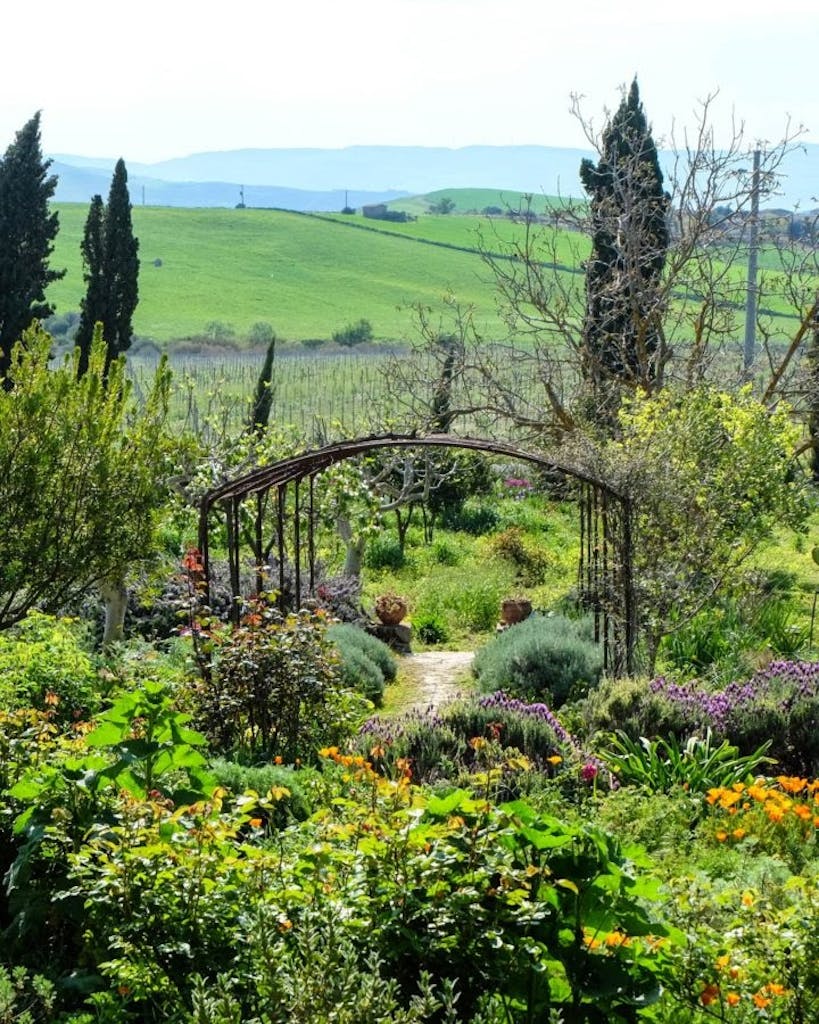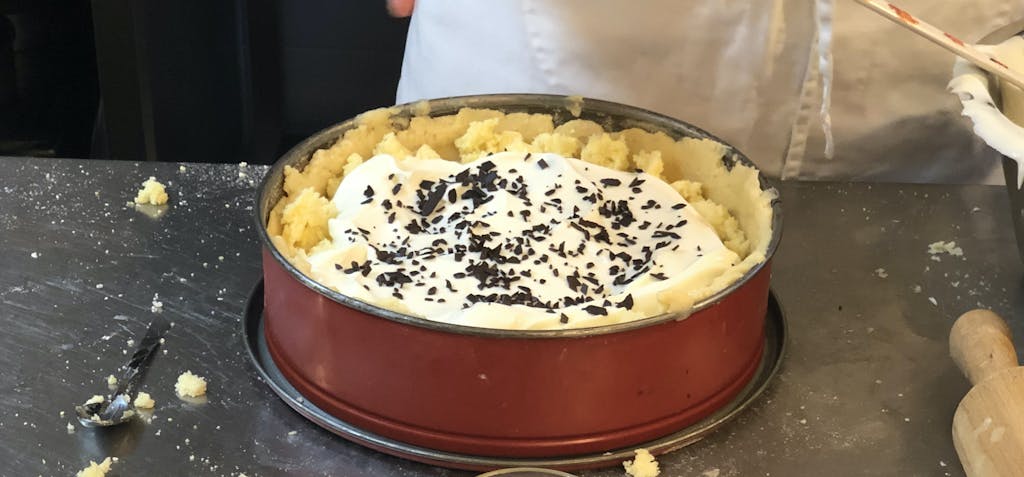Cassata Infornata Sponge Cake: A Sicilian Cake That’s Like Sicily in a Dish
For over three decades, the gardens have erupted and gone dormant near the Case Vecchie, a stone farmhouse on the large, 19th-century estate of Tenuta di Regaleali in Central Sicily. In autumn, the beds of kale, broccoli and wildflowers look austere compared to the abundance of green seen in the hot months, when produce overflows. Through contrasting seasons, we appreciate the bitterness and sweetness of life more deeply, especially in Sicily — and even more so when Sicilian cake is involved.
The creator of these green flowering spaces and tall fruit trees, the late Marchioness Anna Tasca Lanza, has now left this world, but her gardens and cooking school are thriving, thanks to her daughter Fabrizia. The accomplished cooking instructor, filmmaker, cookbook author and founder of a new nonprofit, Food Heritage Association, has perfected her mother’s idea of food as connection.
The Anna Tasca Lanza Cooking School at Tenuta Regaleali in Vallelunga Pratameno stands at the forefront of Sicilian food culture and education. For decades guests and well-known chefs like Alice Waters have come to taste, cook and explore the gastronomy and viticulture of the land. Under the stewardship of Fabrizia, the school has grown into a center for Sicilian cuisine, offering a two-month residency, multi-day workshops and virtual classes was the Queen of Sicilian Cuisine, Fabrizia is a Supreme Court Justice, a master facilitator and arbiter of conversations and experiences around food. She chats with the beloved food writers of our day, Rachel Roddy from The Guardian and Chef David Tanis from The New York Times, to name just a few. This spring, she presented at Oxford to discuss the flavor of bitterness in her new documentary “Amaro.”

Food did not always occupy Fabrizia’s mind. At 45 years old, she decided to set aside a career as a curator of modern and decorative arts in Veneto to return home. In her latest cookbook, “Coming Home to Sicily: Seasonal Harvests and Cooking from Case Vecchie,” published two years after her mother passed away, she described how naturally food replaced her art vocation when she felt her roots again.
Living between Palermo and the interior of Sicily on her family’s estate, she renewed her senses with seasonal recipes. The experience was pure pleasure.
“I realized that learning to make a cassata was no less interesting than analyzing a Botticelli,” she wrote, remembering the period when she started to work with her mother at the school.
Life at Case Vecchie
Fabrizia wakes up early and when she can, she writes before the day’s events invade and strolls through the gardens that she and her mother both cared for, sensing the place where both of their visions mingle.
“I see what I need to do, what should be done in the next season, and I take care of the cutting and seeding,” she said, describing her thoughts on these walks.
Beyond the gardens, fields growing grapes and wheat stretch across the sloped hills. This time of year, the sheep are set to pasture, grazing on wild bitter plants, then shepherded home in the evening to be milked. The milk becomes ricotta, a prime ingredient in the four-course meals at Case Vecchie, whose menus undulate with the temperatures outside and shifts in the seasons.
“I realized that learning to make a cassata was no less interesting than analyzing a Botticelli.”
Fabrizia Lanza, Director of the Anna Tasca Lanza Cooking School
Ricotta tastes best in the winter, especially as a dessert. One of Fabrizia’s favorite recipes involving ricotta came to her later in life: a rustic ricotta sponge cake known as Cassata Infornata. A distant cake cousin to the Cassata Siciliana — that unforgettable pistachio-colored marzipan cake topped with candied orange rinds and cherry — Fabrizia prefers this elegant and ancient version that looks less “dressed up” and “Baroque.” Its essence reveals itself in the mildly sweet interior. The light and creamy ricotta filling floats like a cloud, enveloped by Italian sponge cake and a light shortbread.

Recipe: Cassata Infornata
This rustic Cassata Infornata riccota sponge cake recipe comes from Valentina Chiaramonte, the current chef of the Bib Gourmand-rated Consorzio restaurant in Turin, Italy. Add chocolate to the warm ricotta, Fabrizia said, and it turns out “quite divine.” Pair this Sicilian cake with an Italian dessert wine, a malvasia, marsala or passito, and remember — coffee comes last!

Ingredients:
For the dough:
- 500 grams (4 cups) all-purpose flour
- 100 grams (½ cup) sugar
- 4 grams (½ tsp) ammoniaca or baking powder
- 170 grams (12 tbsp) butter
- 1 egg plus enough milk to equal 100 ml (a little less than ½ cup)
- 8 grams (1 tsp) honey
- 12 ml (1 tbsp) dessert wine
- Pinch of salt
- Zest of ½ lemon
For the sponge cake:
- 3 eggs
- 75 grams (6 tbsp) sugar
- 75 grams (½ cup + 4 tsp) all-purpose flour, sifted
- ⅛ tsp lemon zest
For the ricotta cream:
- 1.25 kg (44 oz) fresh sheep’s milk ricotta, left to strain overnight.
- 350 grams (1 ¾ cups) granulated sugar.
- 50 grams (¼ cup) chocolate chips or chopped bittersweet chocolate
- 25 grams (2 tbsp) candied mandarine or orange (optional), chopped.
Method:
For the dough:
- Pour the flour, sugar, salt, and ammoniaca (or baking powder) onto a work surface or into a bowl and mix thoroughly.
- Work the butter into the flour until the mixture is crumbly.
- Make a well in the centre, add the egg, milk, honey and wine then stir to blend. Knead for as little as possible; the dough should be soft.
- Wrap the dough in plastic and leave to rest in the fridge for at least 30 minutes.
For the sponge cake:
- Preheat the oven to 175°C (350°F).
- Butter and flour a 6” round cake pan. Put the eggs into the bowl of a mixer and beat for 10 minutes. Add the sugar and lemon zest and continue to beat until the mixture forms a ribbon, about 15 minutes.
- In 2-3 parts, gently fold in the sifted flour, then pour into the pan and bake for 20-25 minutes, until a toothpick inserted into the centre of the cake comes out clean. Cool on a cake rack and set to the side.
- In a large bowl, whip the ricotta and sugar by hand with a whisk until creamy or with an electric beater. Fold in the chocolate chips, then keep in the refrigerator until needed.
To assemble:
- Butter the 9-inch spring-form pan, and dust with breadcrumbs.
- Divide the pastry dough into two pieces, one slightly bigger than the other. Roll out the larger piece of pastry dough between two pieces of lightly floured parchment paper until 1 cm (less than ½ inch) thick.
- Peel off one layer of parchment paper, invert the pan over the dough and carefully flip it over. Peel off the second layer of parchment paper and press the dough into the bottom and sides of the pan, smoothing it out as much as possible.
- Crumble two thirds of the sponge cake evenly onto the bottom of the dough. Spread the ricotta cream on top of the crumbled sponge cake, then crumble the remaining sponge cake on top of the ricotta, pressing down lightly.
- Roll out the smaller piece of pastry dough to fit the top of the cake and pinch the edges to seal completely.
- With a sharp knife, make a small cross on top to allow air to escape. Bake at 175°C (350°F) for about 30 minutes until golden brown.
- Rest until cooled slightly, then remove from the pan and leave to cool completely.
- Dust the top with powdered sugar before serving.
Fabrizia’s Tips:
- “Short pastry obviously is important and needs to be good, but this is something not too difficult to do. Make sure that the shortbread pastry rests for a couple of hours once you’ve made it, because that allows the flakiness to come back. You don’t want to melt the butter, you want the pastry to hold on to the fat with some consistency. That allows you to have a nice crunchy crust.”
- “Ricotta should be strained. When we buy fresh ricotta or I buy from the shepherd, it’s like a fluffy marshmallow, super cloudy, and this kind of creamy cheese, so it would be impossible to do anything with it. We let it strain for three days in the fridge, so it loses weight and compacts. If you try to whip that with sugar right away, it will turn to a liquid.
- “With industrial ricotta,” she added, “strain for just one day.”
- “I recommend not using too much sugar. 250 grams per kilo.”
Eager to experience Cassata Infornata and other Sicilian cakes? Consider a Mediterranean itinerary that visits Sicily, especially one with Silversea’s S.A.L.T. culinary program.



















